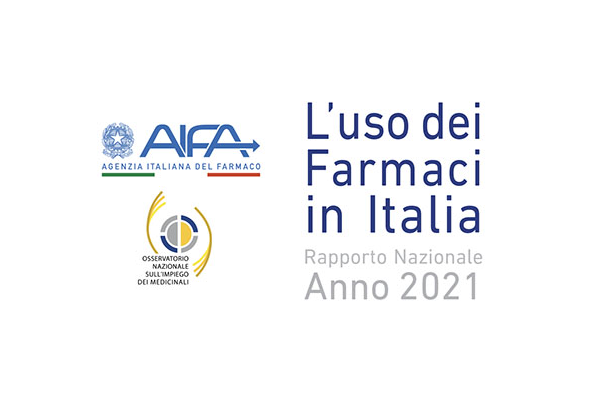
It was presented on July 29th National Report 2021 "The use of drugs in Italy", accomplished  by the AIFA National Observatory on the Use of Medicines (OsMed).
by the AIFA National Observatory on the Use of Medicines (OsMed).
We report some excerpts from the presentation of the Dr Nicola Magrini, AIFA General Manager
The National Observatory on the use of medicines (OsMed) publishes the 22nd National Report on the use of medicines in Italy (relating to the year 2021) with an increasingly exhaustive and critical description of pharmaceutical assistance, a central hub for the health protection, which, for the public component, commits a share equal to over 17% of health expenditure, to which are added a further 9 billion in private expenditure, i.e. paid directly by citizens.
Pharmaceutical expenditure in Italy should be considered overall under control, given that it is growing at a slower pace than the other components of health expenditure (staff, hospital assistance, etc.) even if with numerous areas for improvement for a prescription based on the best scientific evidence and more homogeneous throughout the national territory. However, it should be borne in mind that there is a sharp increase in spending on vaccines, antivirals and monoclonal antibodies for COVID-19 which amount to over 2.3 billion euros for 2021, necessary to deal with the recent and unexpected health emergency.
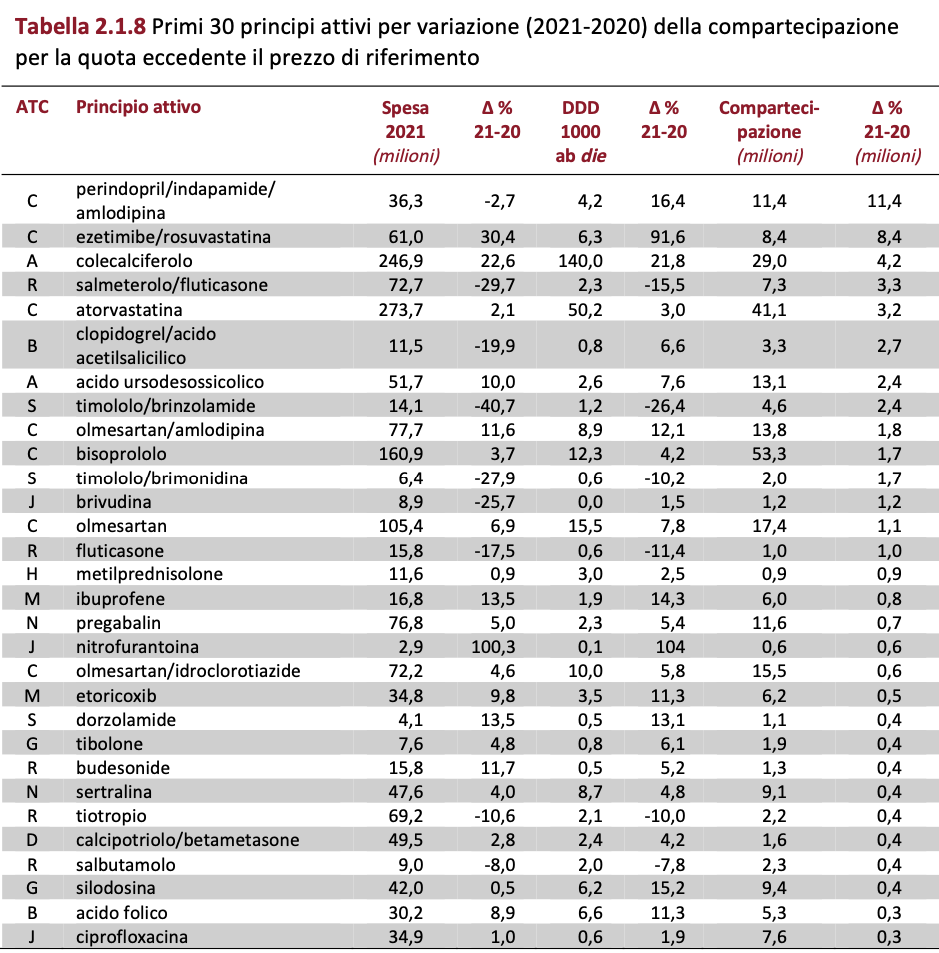 The new regulatory interventions approved by Parliament for 2021 have resulted in both an increase in the resources available for pharmaceuticals thanks to the increase in the FSN but also a remodulation of the ceilings in favor of direct purchases (from 6.89% to 7.85%); this has registered a clear reduction of the breakthrough that must be covered by Regions and pharmaceutical companies.
The new regulatory interventions approved by Parliament for 2021 have resulted in both an increase in the resources available for pharmaceuticals thanks to the increase in the FSN but also a remodulation of the ceilings in favor of direct purchases (from 6.89% to 7.85%); this has registered a clear reduction of the breakthrough that must be covered by Regions and pharmaceutical companies.
A particular comment should be dedicated to the new AIFA Notes which have marked an important change of orientation becoming known for pathologies (vit.D, respiratory, intravitreal and diabetes) and no longer for single drug, allowing a greater ability to address the prescription according to the best scientific evidence.
A critical and cautious note should be formulated on private spending (at the expense of citizens) which is a chapter in progressive increase in the last 10 years and will exceed 9 billion in 2021: this expenditure must be considered to all intents and purposes as sometimes improper health care expenditure and to be kept more under the magnifying glass of the actions of prescribing appropriateness and good use of drugs.
The Report, drawing from the various information flows and with its detailed analysis, highlights the information potential of our NHS, able to provide the necessary elements for the implementation and evaluation of policies for the sustainability of pharmaceutical expenditure. However, a cultural change is necessary that leads to at least a three-year plan (2022 - 2024) that defines programmatic objectives of the system in the context of the overall sustainability of the NHS of which AIFA is a part and provides greater elements of understanding to citizens and patients of like all the most expensive and most important chronic innovative therapies, they are guaranteed in Italy in a universalistic way (to all) and free of charge.
Francesco Trotta, manager of the HTA and Pharmaceutical Economics Sector, underlined the key messages of the Report: “Total pharmaceutical expenditure in 2021 is 32.2 billion euros (+3.5% compared to 2020), of which 69.2% is reimbursed by the National Health Service, with private spending growing more than public spending. The cost for each patient is 543.8 euros (of which 376.3 euros paid by the NHS). Most of the consumption is absorbed by the territory (87%), where chronic pathologies are mainly treated, with a lower cost (41%). Conversely, the consumption of drugs is lower in hospitals (13%), where acute or complex pathologies are treated, for a greater expense (59%)”.
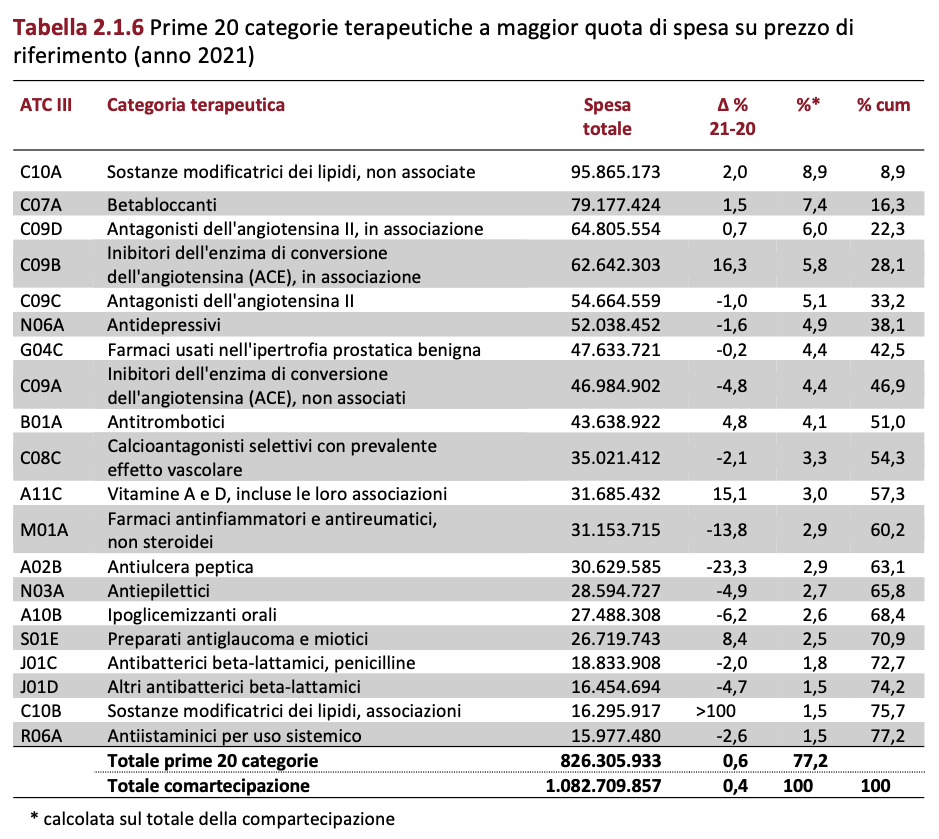 Roberto Da Cas (Istituto Superiore di Sanità) instead analyzed the trend of consumption and expenditure for the main therapeutic categories: "Oncologicals are the first category of expenditure, doubling in 8 years from 2.1 to 4 billion euros, followed by antihypertensives, immunosuppressants, antidiabetics and drugs for asthma and COPD, with a certain stability both in terms of expenditure and consumption compared to previous years. Over 17 million Italians use antibiotics, almost 12 million use antihypertensive drugs. Followed by prevalence of use are drugs for ulcers and gastroesophageal reflux (11.8 million Italians), those for diabetes (3.7 million Italians) and antidepressants (4 million).”
Roberto Da Cas (Istituto Superiore di Sanità) instead analyzed the trend of consumption and expenditure for the main therapeutic categories: "Oncologicals are the first category of expenditure, doubling in 8 years from 2.1 to 4 billion euros, followed by antihypertensives, immunosuppressants, antidiabetics and drugs for asthma and COPD, with a certain stability both in terms of expenditure and consumption compared to previous years. Over 17 million Italians use antibiotics, almost 12 million use antihypertensive drugs. Followed by prevalence of use are drugs for ulcers and gastroesophageal reflux (11.8 million Italians), those for diabetes (3.7 million Italians) and antidepressants (4 million).”
On vitamin D, General Manager Magrini, announced that “a review of the Note 96 which had already led to a more targeted use of this drug”, producing “a saving of several tens of millions a year”. In support of this statement he cited the recent item published in the New England Journal of Medicine (NEJM), which, moreover, deals with a supplement and not a drug. The study demonstrates that supplemental vitamin D3 (2000 IU/pd), compared with placebo, had no significant effect on total fractures. Participants were not recruited on the basis of vitamin D deficiency, low bone mass, or osteoporosis. The primary end points were total accident, non-vertebral and hip fractures. Proportional hazard models were used to estimate treatment effect in intention-to-treat analyses. In essence, taking vitamin D as a supplement offers no protection from fractures in the elderly.
The same study had previously found that getting plenty of vitamin D didn't even prevent heart disease, cancer or memory loss. The study, according to the Dg Aifa Nicola Magrini, makes "a revision of Note 96 is likely soon”.
In “an accompanying editorial” signed by “some well-known osteoporosis scholars”, experts conclude that “we can no longer speak of vitamin D insufficiency except in extreme cases – reported Magrini – that it makes no sense to measure blood levels of vitamin D as it was and is done, and that people should stop taking vitamin D supplements to prevent major disease or extend lifespan.”
______________________________
The case of Vitamin D
From an epidemiological point of view, reports OsMed, it is estimated that in Italy about 3.5 million women and 1 million men have osteoporosis and the numbers seem destined to grow with the expected increase in the over-65 population over the next 25 years. As far as fractures are concerned, in the over-fifty population the annual number of hip fractures is around 90,000, while it is believed that there are around 70,000 vertebral fractures, probably underestimated because they are largely asymptomatic.
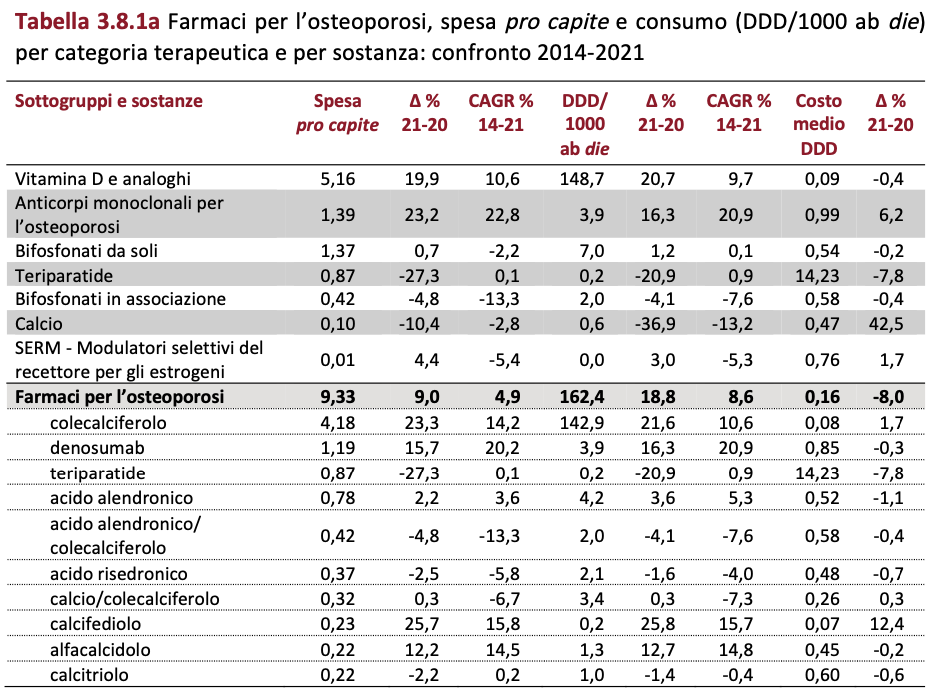 The consumption trend of drugs for osteoporosis (including vitamin D and metabolites) shows a significant increase between 2014 and 2019 with a decrease in 2020 due to the entry into force of the AIFA Note 96 (With the'attachment 1) of 26% and a new increase of 20.7% in 2021. The average cost per day of therapy remained fairly stable over the entire period, standing at 0.16 euros in 2021. The per capita expenditure for these drugs is equal to 9 .33 euro, an increase of 9% compared to the previous year.
The consumption trend of drugs for osteoporosis (including vitamin D and metabolites) shows a significant increase between 2014 and 2019 with a decrease in 2020 due to the entry into force of the AIFA Note 96 (With the'attachment 1) of 26% and a new increase of 20.7% in 2021. The average cost per day of therapy remained fairly stable over the entire period, standing at 0.16 euros in 2021. The per capita expenditure for these drugs is equal to 9 .33 euro, an increase of 9% compared to the previous year.
Expenditure on vitamin D and analogues (5.16 euros per capita) represents approximately 50% of the expenditure of the entire category with an increase of 20% compared to 2020. The reason for this The increase can be attributed mainly to the unproven protective effect against COVID and only partially to the physiological dilution of the braking effect of the note on the prescription. This finding underscores the extensive use of cholecalciferol and metabolites for extra-skeletal indications for which RCTs have not provided evidence of efficacy.
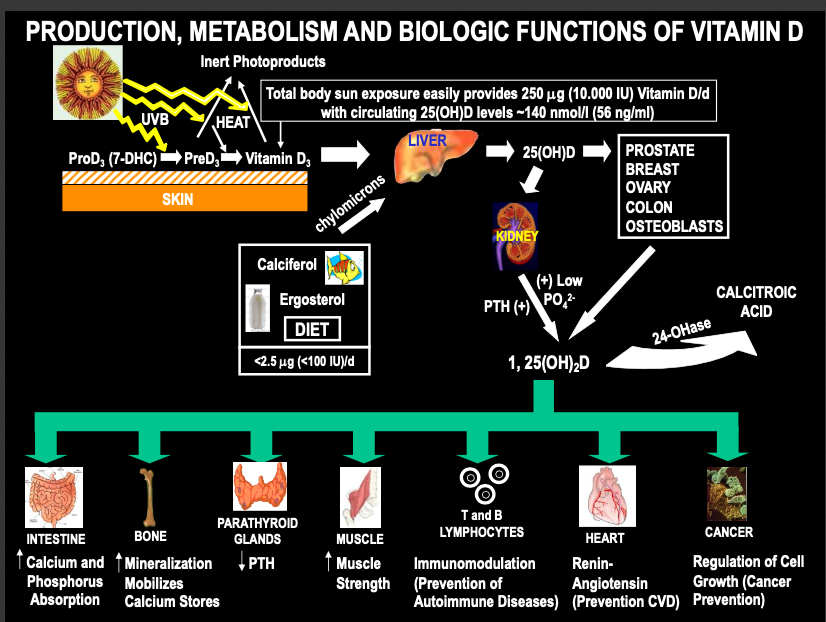 Analyzing the individual active ingredients, colecalciferol represents the molecule with the highest per capita expenditure (4.18 euros) and consumption (142.9 DDD/1000 inhabitants per day). Teriparatide, despite the availability of biosimilar medicines, records the highest cost per day of therapy of the entire category (14.23 euros), a slight decrease compared to 2020 (-7.8%). (Source OsMed 2021)
Analyzing the individual active ingredients, colecalciferol represents the molecule with the highest per capita expenditure (4.18 euros) and consumption (142.9 DDD/1000 inhabitants per day). Teriparatide, despite the availability of biosimilar medicines, records the highest cost per day of therapy of the entire category (14.23 euros), a slight decrease compared to 2020 (-7.8%). (Source OsMed 2021)
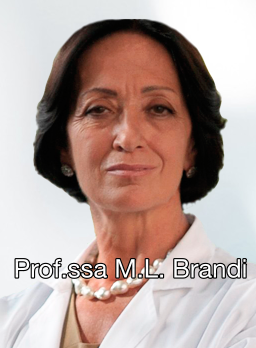 The blaming of vitamin D3 is not new. Prof. Maria Luisa Brandi he wrote in 2018: “In our country there have been 560,000 fractures from osteoporosis (about 100,000 of the femur) with a cost for the national health system of 9.4 billion euros. But this annual expenditure is projected to increase by nearly 26% (to €11.9 billion) by 2030.
The blaming of vitamin D3 is not new. Prof. Maria Luisa Brandi he wrote in 2018: “In our country there have been 560,000 fractures from osteoporosis (about 100,000 of the femur) with a cost for the national health system of 9.4 billion euros. But this annual expenditure is projected to increase by nearly 26% (to €11.9 billion) by 2030.
The burden associated with fragility fractures in Italy exceeds that associated with chronic obstructive pulmonary disease (COPD) and ischemic stroke, and when comparing costs associated with fractures and the total cost of healthcare, Italy has the highest proportion of expenditure destined to this problem compared to the other five countries included in the international report which compares the Italian situation with that of five other countries (France, Spain, UK, Sweden, Germany).
Study results demonstrate that despite the availability of effective preventive therapies and management approaches for fragility fractures, only 20% of patients are treated pharmacologically. “Each fracture increases the risk of sustaining a new fracture fivefold”, explains Prof. Maria Luisa Brandi, president FIRMO Foundation.
What exactly happens? The authorization to prescribe these drugs belongs only to a few authorized centres, while the general practitioner is limited in the choice: either to prescribe generic drugs or to prescribe the much debated vitamin D. “For this reason – noted Brandi in 2018 – in Italy there are many vitamin D prescriptions, unlike those of post-fracture drugs ".
Therefore, despite the existence of drugs and the provisions of Aifa (Italian Medicines Agency) to treat certain patients with this therapy, this is not done in Italy. “Perhaps a role in this whole story is to be attributed to the scandal calcitonin in the early 90s, when in Italy this drug was prescribed for osteoporosis and it didn't work. Surely – Brandi says – it was an episode that marked this area of medicine in a negative sense, but the situation could be unblocked with the issuing of guidelines that have legal value and that allow everyone to access therapies”. (Taken from Fractures and osteoporosis, the alarm of the experts)
Today, says Prof. Brandi, there is a much wider variety of osteoporosis medications available than ever before. The type of treatment you will be prescribed depends on your personal risk profile. The drugs have been shown to reduce the risk of hip fracture by up to 40%, vertebral fractures by 30-70% and, in some cases, to reduce the risk of non-vertebral fractures by 30-40%.
Your doctor may also prescribe calcium and vitamin D supplements to ensure you have enough of these important nutrients.
Today, says Dr. Luca Degli Esposti president of Colicon, the cost of a patient with a fragility fracture is a total of 6,500 euros in the year following the event: 1,000 euros for drugs, 4,500-5,000 euros for subsequent hospitalizations/procedures, 700 euros for tests/and other visits. The cost of a fragility fracture patient is significantly higher than the cost of patients of the same age and gender who have not experienced this event. This cost varies greatly according to the degree of compliance with the therapeutic recommendations which, according to the Note 79, they involve the use of drugs for osteoporosis, supplementation with calcium and vitamin D and their continuous maintenance over time. Compared to the average value of 6,500€, it ranges from a minimum of 4,000 for those who respect note 79 to a maximum of 9,000€ for those who do not respect it. The explanation for this difference is the hospitalization costs of the refractions. Therefore, greater compliance with the recommendations, lower risk of fracture events, lower overall care costs.
The Higher Institute of Health published the document on October 21, 2021 Diagnosis, risk stratification and continuity of care of fragility fractures, the first guideline in the field of fragility fractures in our country and one of the first in the world, created by the University of Milan Bicocca in collaboration with the Frame Coalition (a multidisciplinary and multiprofessional alliance with the involvement of 18 patient associations) and the coordination of ALTIS-IHPB.
Related news:
Video Presentation OsMed Report 2021 "The Use of Medicines in Italy"
Supplemental Vitamin D and Incident Fractures in Midlife and Older Adults
Villa Donatello symposium publications “vitamin D: instructions for use”
Fragility fractures: an Italian emergency – analysis of the problem and its solutions
Garattini: In the South, sun and sea, why are more drugs prescribed?





